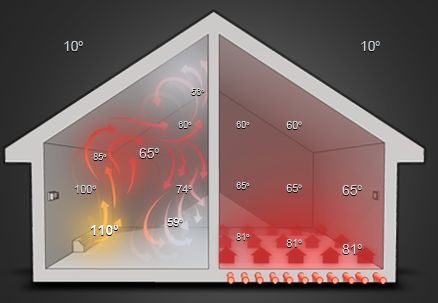
- By admin
- In Build, Design, Flooring, Renovation
Which Is Better, Forced-Air or Radiant Heat?
In the radiant floor vs. forced-air heating debate, radiant floor always wins because it provides a quiet, even heat and eliminates the allergy problems often associated with heating ducts. But there’s another reason why radiant floor heating is superior to its blowy cousin—it’s simply more efficient.
The Problem with Forced Air
Anyone who’s ever lived with a forced hot air system is familiar with the challenges of this type of heat, which is akin to warming your home with a series of hot-air hand dryers mounted in the ceiling or floor. The room warms quickly, but then cools equally fast, forming a yo-yo heating pattern that can prompt you to constantly adjust your thermostat, causing your furnace to turn on and off, wasting energy.
Forced hot air systems are also subject to something known as parasitic heat loss. Because the air from the furnace and air handler has to travel through a series of tubes to get to its intended room, there are many opportunities for it to leak wherever there are small openings in the ducts. Also, the ducts for this type of system often travel through cold attics or basements, increasing the chance that heat will be lost as the warm air travels to the rooms in your home.
The warm air released by forced-air systems either pumps out through grates in the ceiling, where it tends to stay, or it shoots out of vents in the floor and flies quickly up to the ceiling. The result is stratification—a situation where the top of your room is warm (sometimes as much as 10 degrees warmer) and the center and bottom part of your room is cooler. This means you’ll turn your thermostat up higher to get the heat to reach the portion of the room in which you actually live. All this air movement also has the paradoxical effect of cooling you. Think about being outside in the sun on a cool day. You might feel comfortable in a short-sleeved shirt until a breeze blows. Forced hot air systems create breezes in your home all the time.
Finally, it is difficult to create zones with a forced hot air system. As a result, you have to heat your entire home to one temperature, or, if you have a dual-floor system, you have to heat an entire level. Because you might need heat only in the few rooms you occupy the most, you are effectively throwing money away by warming empty spaces.
The Benefits of Radiant Heat
A radiant floor system solves all of the inefficiencies inherent in forced-air systems, with some studies showing that they are as much as 30 percent more efficient.
Because the heating panels are in direct contact with the floor, there is very little parasitic heat loss, as there are no long pathways for the warmth to travel. Air doesn’t shoot out of vents in this kind of system, so there are no breezes to contend with, which allows you to keep the thermostat lower. The blower in a forced-air system typically requires nine times the electricity used by the pumps in radiant systems. Plus, the heat is also more consistent with radiant flooring. Rather than getting blasts of warm air that dramatically raise the room’s temperature, radiant heat provides a continuous level of warmth, which means less fussing with the thermostat.
Another major benefit of radiant over forced-air heating is the fact that 50 percent of the heat it produces comes from infrared, a form of invisible light. This type of heat works best as you get closer to it (think about a light bulb); therefore, because radiant heat is embedded in the floor, it will keep you warmer than heat that congregates up near the ceiling. This saves energy not only because you can lower your thermostat, but also because radiant systems need to produce heat in just the 75 to 80 degree Fahrenheit range, as opposed to the 120 to 140 degree Fahrenheit temperatures generated by forced-air systems.




7 COMMENTS
Afton Jackson
December 21, 2020, 5:53 am REPLYThe fact that radiant heating is much quieter than forced-air heating was my favorite takeaway from this article. Peace and quiet are two things I value the most whenever it’s time to go on vacation, but with large appliances like furnace heaters operating, this can be quite hard to achieve. If I can have an HVAC contractor replace my current system with a radiant in-floor system, I’ll definitely enjoy my vacation more.
Tyler Johnson
January 28, 2021, 5:36 pm REPLYThat’s good to know that radiant heat is around 30% more efficient. I feel like that would help you save on energy bills quite a bit over time. I’ll make sure to go with radiant heat if I decide to get some heated floors.
North Vancouver Heater Repair
March 9, 2021, 6:21 am REPLYThis is a very informative blog, thanks for sharing about which is better forced airor radiant heat. It will help a lot; these types of content should get appreciated. I will bookmark your site; I hope to read more such informative contents in future.
North Vancouver Heater Repair
March 9, 2021, 6:21 am REPLYThis is a very informative blog, thanks for sharing about which is better forced airor radiant heat. It will help a lot; these types of content should get appreciated. I will bookmark your site; I hope to read more such informative contents in future.
Mia Evans
March 12, 2023, 8:12 am REPLYI love that you talked about having a continuous source of heating with certain systems which can reduce the need to adjust the thermostat. I wonder if that is the kind of unit in the house that my husband will inherit. We have to know what type it is because we might consider getting a hydronic heating system repair if that is what the property has before we move into it.